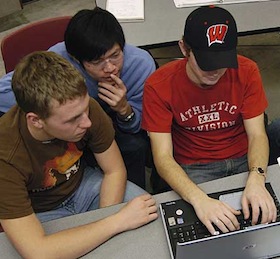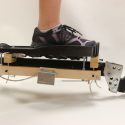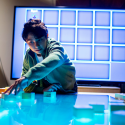Engineering moving classroom into digital age
The Internet has profoundly affected the lives of those born into an information-saturated world, the “digital natives.” It has shaped nearly all of their expectations of the world, including what they expect from an institution of higher learning.

The College of Engineering Academic Planning Council set a strategic directive of moving 75 percent of engineering core courses to a new “blended learning” model that leverages video-captured lectures and Web-based course management tools to enhance in-class instruction. Photo: Michael Forster Rothbart
Recognizing the shifting expectations for higher education, UW–Madison’s College of Engineering formed Engineering Beyond Boundaries in 2005 as a college-wide attempt to identify new approaches to teaching students of the Internet age.
“The objective was to adapt teaching for a new learning environment,” says Steve Cramer, associate dean for academic affairs for the College of Engineering.
Part of the college’s efforts to adapt came in the form of proposals from faculty for innovative instructional uses of technology. Forty-two pilot projects for technology-enhanced teaching have been funded since 2007.
But as innovative and effective as these were on a class-by-class basis, most were still limited in scope.
“If we were really going to change how engineering is taught at Wisconsin, it couldn’t just be in a brand new, ‘one-off’ elective course,” says Cramer. “It had to hit the core of our courses, and it had to be implemented in a sustainable way.”
Thus, the College of Engineering Academic Planning Council, with encouragement from the College’s Industrial Advisory Board, set a new strategic directive: moving 75 percent of engineering core courses to a new “blended learning” model that leverages video-captured lectures and Web-based course management tools to enhance in-class instruction.
It’s an ambitious goal that aims to use college-wide technology-support services to help instructors replicate prior successes in technology-enhanced courses taught by early adopting faculty members.
Capturing lectures and putting them online is only one part of the equation; the ultimate benefit of a blended approach is to draw from the best of both online and offline learning, leveraging the efficiency of Web-based information tools to improve the quality and quantity of time students have to work in small groups with their professors.
“There’s a pathological fear that student performance will worsen if you don’t lecture to them,” says Greg Moses, Harvey D. Spangler professor of engineering physics and one of the college’s pioneers in blended learning. “But there’s no evidence of that.”
Moses points to psychologist Benjamin Bloom’s taxonomy of learning domains as a model for divvying up online and offline material within a course. Basic knowledge acquisition, comprehension and application suit Web-based learning tools well, while analysis, evaluation and synthesis with other concepts function best in work sessions between students and professors.
“You’ll be surprised at how much of your courses fit into the first three categories,” says Moses.
“Shallow” course content geared toward imparting basic facts works well online, since students can learn on their own time and at their own pace—without affecting the quality of their experience.
Conversely, says Moses, “deep” course content with heavy group problem solving and collaboration might not work online at all.
“If there’s a lot of discussion and analysis, lots of ‘what-if’ thinking, perhaps that’s best left for the classroom,” he says.
He says a blended approach means that mixing and matching online and offline learning is fine, even encouraged, so long as the information being taught fits the approach.
Moving core course information to the Web does require students to be more accountable for their own education — something Moses believes could be addressed through a “how to learn online” prep course for freshmen.
“They need to develop the attention span and right frame of mind needed to treat online lessons the same way that they would treat dragging themselves out of bed to get to class every morning,” he says.
Naturally, blended learning approaches rely heavily on technology resources, but in the College of Engineering, Wendt Commons — a recent merger of the Engineering Learning Center, Wendt Library and Engineering Media Services — has made it easier for faculty to connect with learning technology resources and experts.
Wendt Commons serves as an engineering-focused suite of technology support — similar to the advice, audio and video recording tools, and Web-based course management tools offered at the university level by DoIT Academic Technology and the Digital Media Center.
Wendt Commons provides a one-stop shop for instructors looking advice for on how best to apply technologies to enhance their courses.
“Usually, instructors will come to us with a particular problem they need to solve or a change they want to make,” says Deborah Helman, director of Wendt Commons. “We’re helping them connect different pedagogical approaches and class activities with some of the appropriate technologies. We provide a very holistic approach.”
Wendt Commons staff can connect faculty and instructors with resources ranging from an on-staff instructional designer to frictionless video capture of their lectures and information technology support for web-based teaching software.
“The 50-minute lecture is one of the most inefficient methods for human learning to occur.”
John Booske
John Booske, Duane H. and Dorothy M. Bluemke professor of electrical and computer engineering, says the ease of capturing and posting video lectures online has been key to increasing the quality of the time he spends with his students. He spends less time preparing for lectures each week, and students are able to work through lecture content at their own pace, watching two to three topic-based “lecturettes” that they are quizzed on the start of each class.
“The 50-minute lecture is one of the most inefficient methods for human learning to occur,” says Booske. “Permanent memory is — for most of us — limitless, but it all has to go through working memory, which is a very limited cache process. We process knowledge best in chunks.”
Moving lecture content online affords instructors like Booske the flexibility to spend the time that would have been taken up by lecturing on supervised application of the concepts in the course. “I walk around the classroom as a coach,” says Booske. “I keep them on task, using more of a Socratic method — rather than telling them the answers.”
The Wisconsin Collaboratory for Enhanced Learning Center, or WisCEL, serves as the latest learning asset available to instructors interested in a blended instruction model. At night, the technology-rich spaces on the fourth floor of Wendt Commons and the third floor of College Library provide a study space with rooms for breakout discussions and tables with plenty of power and Ethernet jacks for student gadgets. During the day, it provides an inverted classroom that makes teaching more spontaneous and personal than in a traditional lecture hall.
Michael Morrow, a faculty associate in electrical and computer engineering, moved his circuit analysis courses into WisCEL two days a week in spring 2012.
He, too, says his interactions with students—and students’ with each other—are more substantial now that in-class time can be dedicated to hands-on work under his guidance.
“Students come more prepared to WisCEL than they ever come to lecture,” Morrow says.
In Morrow’s and Booske’s enhanced personal time with their students, the reason to leverage blended learning becomes immediately apparent.
“If people can get all our lecture content online, what’s the value added from paying for a college degree?” Morrow asks. “I think that it’s in experiences like those in WisCEL.”
Representatives from across the engineering campus – including Dean Paul Peercy, Associate Dean for Academic Affairs Steve Cramer, WisCEL Director Deborah Helman, Harvey D. Spangler Professor of Engineering Physics Greg Moses, Duane H. and Dorothy M. Bluemke Professor of Electrical Engineering John Booske, Chemical Engineering Professor Daniel J. Klingenberg, and Electrical and Computer Engineering Faculty Associate Michael Morrow – spoke at a May 10 workshop where they shared successes and failures along the way to developing a blended approach to modern instruction. Another blended learning workshop is planned for fall 2012.



